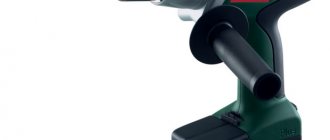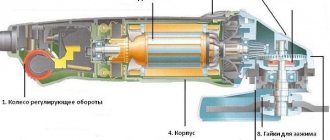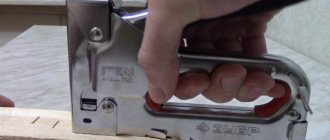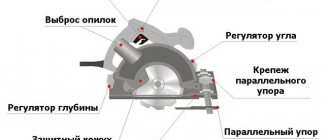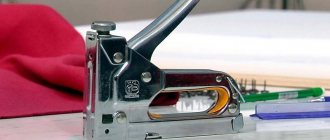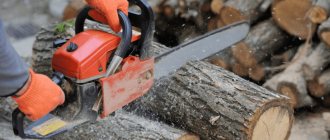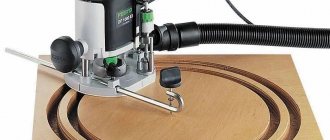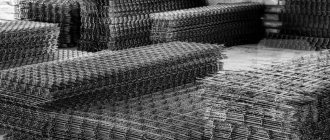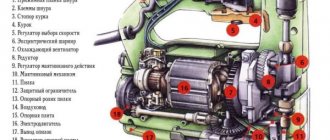It would seem that nothing could be simpler than a stepladder! Surely, our parents didn’t bother with the choice and bought the first one they came across, or even made it with their own hands. However, there wasn’t much choice before. Now everything is different. Stepladders differ in height, design, number of steps, load capacity and material of manufacture. Which stepladder should you buy for your needs? Below we will look at the existing assortment and find out how to choose a stepladder for an apartment or a house, depending on what tasks are assigned to it.
The best stepladders with a platform height of 0.6 - 0.7 m
Models with a platform height of 60-70 cm from the floor are neat and compact. By standing at the maximum permitted height, a user with a height of 160-180 cm will be able to carry out work without reaching the level of 250-280 cm. This is enough for renovation work in apartments with ceilings of 2.5 m or in private houses with walls of low height. But they are not suitable for private houses with ceilings of 3 m or higher.
Eiffel Duet 203
The stepladder is made of aluminum and does not have a support platform - instead, the manufacturer has provided it with steps on each side, so you can stand with both feet at the same time on the first or second row. It is allowed to put one foot on the third step, provided that the other foot is kept on the second row.
+ Pros Eiffel Duet 203
- The light weight of 3.2 kg allows even a child to carry it easily.
- The vertical posts are equipped with anti-slip tips - this allows it to be used on tiles, parquet and laminate.
- Grooved treads help ensure firm placement and prevent the soles of the user's shoes from slipping.
- The corners of the steps are covered with plastic caps to prevent accidental snagging and injury.
- Fixing the sliding hinge with four rivets to each post.
- Climbing from any direction.
- Seat belts prevent the legs from moving apart.
- Easily fits into the trunk of a car without folding the second row backrest.
— Cons Eiffel Duet 203
- For users with large feet (44 or more), the steps will be narrow and uncomfortable.
- The straps are short in length - if they slightly touch the stepladder, they tighten the racks and you have to often adjust the position before climbing it.
- The racks are not fixed in an extended position - when moving over short distances, you need to fold and unfold them each time.
- You may get your fingers pinched if you grasp it in the wrong place.
Conclusion. A good stepladder for an apartment to make it easier to carry out basic processes: hanging a picture, replacing a light bulb in a chandelier, putting things in the mezzanine under the ceiling. When folded, it measures 78cm and fits easily in a pantry or under a bed.
Nika SM3
Russian-made stepladder made of steel. The folding platform has three anti-slip discs and a knee rest for standing on it with both feet.
- The working load is allowed up to 150 kg, which will suit most users.
- The width of the ladder is 600 mm, which is convenient for stability and comfortable climbing.
- The average working height is 282 cm.
- The surface of the steps is corrugated to prevent slipping.
- Rubber stops on the ends of the racks.
- Bolted connection of sliding parts.
— Cons of Nika CM3
- The narrow 65mm steps are uncomfortable for most users.
- Weighs almost 5 kg.
- Steel is susceptible to corrosion and over time, if used or stored in a damp area, it will begin to rust.
- The racks are made of pipe with a cross-section of 0.8 mm - a careless blow to a corner can lead to a dent.
- You need to pay attention to the position of the platform before climbing the stepladder - if the jumper does not fit into the fixing groove, the legs may move apart from the load.
Conclusion. This stepladder is good for electrical work in an apartment: hanging a chandelier, connecting wires in a box under the ceiling. On the partition, for resting your knees, there is a tray for tools and small things - the master does not have to go down every time for the necessary part or stuff everything into his pockets.
Krause TOPPY XL 130877
The stepladder from the German brand features three wide steps with rubber mats inside. The platform height of 0.7 m provides a working height of up to 2.7 m. Made of thick aluminum.
+ Pros Krause TOPPY XL 130877
- Supports a user weighing up to 150 kg.
- Snap lock to prevent the posts from coming apart.
- Plastic caps on the legs allow you to install the stepladder on slippery surfaces.
- Rubber covering on every step.
- The safety bar is 60 cm high and serves as a reliable support, making it very difficult to accidentally fall over.
- Not subject to corrosion.
— Cons of Krause TOPPY XL 130877
- The cost of 5,000 rubles is very high for a small stepladder.
- When folded, it takes up 1400 mm in height.
- Swings under users heavier than 130 kg.
- Packaged in film - when purchased online and delivered by transport companies, it often arrives beaten.
Conclusion. An excellent stepladder for wallpapering an apartment, including the ceiling. All three steps of the same width of 250 mm and length of 375 mm allow you to comfortably stand at any desired height without holding on with your hands.
Features of lifting devices from 2 to 4 meters
Stepladders with a length of 2-4 meters are made in various design solutions.
Pristavnaya
The design includes steps, the number of which depends on the height, and 2 metal profiles that serve as supports. This type of product is needed in order to perform manipulations at a considerable distance from the floor. The staircase is equipped with handrails and comfortable landings. It can be folded into a compact size for carrying and storage. Has the following features:
- guaranteed stability is achieved by attaching the device to the building or using additional supporting elements;
- allows you to work above 1 meter;
- models intended for domestic use have a height of no more than five meters.
How to choose a stepladder size
kak-vybrat-razmer-stremyanki-7
kak-vybrat-razmer-stremyanki-8
kak-vybrat-razmer-stremyanki-9
Sliding
This type of stairs is used in the form of lifting devices with one block or two. This type of stepladder has an additional section that extends to its full length or part of it. Features of these designs:
- convenient to work at significant heights;
- can be configured in a few clicks;
- in some models, the upper section is equipped with rollers, with their help the structure can be laid out along the wall;
- the ladder can be folded for movement;
- each block can be used as a separate staircase;
- the use of fasteners and clamps ensures the reliability of the connecting structures between the blocks.
- The length of the device is adjusted using a retractable block.
kak-vybrat-razmer-stremyanki-20
kak-vybrat-razmer-stremyanki-30
Mobile
The mobile type is similar in appearance to the sliding ladder, they are the same in functionality. This stepladder is equipped with small wheels at the bottom. Features of mobile models:
- they are brought into working position by fixing the wheels to provide stability;
- To move the structure, the clamps are removed;
- the entire upper part of the stairs is raised.
kak-vybrat-razmer-stremyanki-14
kak-vybrat-razmer-stremyanki-15
How to choose the right stepladder?
How to choose the right stepladder?
Every person at least once in his life is faced with the question of choosing a stepladder. Paint the ceiling, nail a shelf, hang or remove curtains, connect a new chandelier; human height is not enough for these jobs. You can use improvised “enlargers” such as tables, chairs or stools, but they are not always of the required height, and in some cases they are simply unsafe. It is for such cases that stepladders are needed. What types of stepladders are there?
1. Household and professional. The latter are designed for constant use, so they have reinforced crossbar attachment points, the crossbars themselves are wider, and the profile has additional stiffening ribs. This allows you to increase the load and service life of the product. A household ladder or stepladder is suitable for household work.
2. Single-sided and double-sided. That is, the steps can be on only one side or on both. Double-sided ones allow, without moving the stepladder from place to place, to carry out work over a wider area or to work together, for example, when you need to feed something. It is worth noting that one-sided stepladders have less weight (this makes them easier to carry and transport) and dimensions (this will save space when storing them). In household use, single-sided stepladders are commonly used.
3. Wooden, aluminum, steel.
A wooden stepladder is, first of all, aesthetics. Compared to metal, it looks more noble. This is important if there is nowhere to store the stepladder, but you don’t want to spoil the interior. On the other hand, like any wooden product, it requires some care. In order for a wooden stepladder to serve for a long time, it needs to periodically change its protection (impregnation, varnish); it cannot be stored outdoors, in dampness or, conversely, in a very dry room. But cost is also an important factor - the price of a wooden stepladder is an order of magnitude higher than a metal one. And it is heavier in weight.
Material of manufacture
What a stepladder is made of also affects many indicators, including reliability, weight and cost. Most often they are made of metals, although there are still models made from other materials on sale. Each of them has its own characteristics and you also need to familiarize yourself with them in advance in order to choose a staircase that will best suit your needs and personal preferences.
Metal
In this case, the stepladder can be made of steel, aluminum, duralumin, silumin and other alloys. The production of folding stairs from them is carried out most often, reaching about 80%. Metal stepladders are characterized by an increased level of strength, high practicality and a long service life.
Models made of aluminum and alloys are not subject to corrosion, and the products themselves are affordable and of optimal quality. The first two metals are the most common, which is why they should be considered in more detail.
Aluminum stepladders, which are lighter in weight, are much more often chosen for homes, while steel models, which are more durable and reliable, are preferred by professional builders. Despite this, in the first staircases the main parts are made from a second material, due to which they do not have a huge weight and at the same time have increased strength.
Due to their lower weight, aluminum stepladders are much easier to move from one place to another, and steel models, due to their increased level of strength, can withstand quite impressive loads without damage. The disadvantage of the latter, in addition to their greater weight, lies in their larger dimensions, which they have when folded.
Wood
Wooden stepladders are the best option exclusively for home use and occasional use. Models made from this material are an order of magnitude cheaper than metal structures, but they are also somewhat inferior in service life, including due to rapid wear at the fastening points. In addition, the disadvantage of such stepladders is their heavy weight.
The positive side of folding stairs is their extremely attractive appearance, thanks to which they can be used as an interior item, for example, on which flowerpots can be placed. If you wish, you can even make a wooden stepladder with your own hands, but in order to avoid rotting of the material under the influence of moisture during further use during manufacturing, it must be treated with special compounds.
Plastic
They are made from rigid polyurethane or plastic. They look like ladder-stools and are intended for domestic and professional needs, but usually the height of such models does not exceed 67 cm. The strength and reliability of a stepladder is directly affected by the quality of the material used during its production, which is why when choosing, you must make sure availability of appropriate certificates. Basically they have 2-3 stages.
The positive side of plastic models is their compact dimensions and low weight, which make them easy to move, which is especially important for regular use. The disadvantage of such stepladders is the huge likelihood of damage when the maximum permissible load is exceeded, which should be taken into account when choosing.
Fiberglass or fiberglass
Professional stepladders, which are intended for use during work that involves electricity, since the materials used as a basis for their manufacture do not allow the passage of current. For use at home, purchasing such models is not advisable.
Tools
Almost every person faces the question of how to choose the right stepladder. After all, this thing is indispensable both in construction and industrial production, and in the household.
Need to sort through things in the mezzanine? Dust the cabinets? Whitewash the ceiling? Change wiring? Pick apples from the garden? In any of these situations, it will come to the rescue - a practical stepladder. In a house, in an apartment, in a country house, in a garage - such a device will come in handy everywhere.
To use this “device” with benefit and pleasure, you should purchase the model most suitable for your needs. But is it so easy to make a choice? Of course not. Although before going to the store it seems completely different.
The range of stepladders on the market is unusually large - the variety of designs, materials and, of course, prices are dizzying. And how do you know which stepladder to choose? Knowledge about the types, capabilities, advantages and purposes of various solutions will help you decide more quickly and confidently on the optimal model.
Table of contents
Key features of a quality product
Whatever purpose a stepladder is purchased for, there are a number of requirements that a design that claims to be good must meet. Among them:
- sustainability;
- build quality;
- safety and ease of use;
- mobility.
Sustainability
The product should not swing or slide under any circumstances. At any stage of the design, the “user” should feel confident. Maximum operational comfort is usually achieved by a stepladder with wide steps.
Build quality
A high-quality stepladder can be easily recognized by the reliable connection of all elements, their evenness and accuracy; absence of dents, burrs, and deformations.
Safety and ease of use
The ergonomics and safety of a stepladder are determined by the presence of:
- anti-slip corrugation on steps;
- securely fixed platform of adequate thickness;
- plastic covers covering metal cuts and sharp parts;
- rubber or plastic tips protecting the legs of the support. These small details prevent the posts from moving apart on slippery surfaces and prevent scratches and damage to the flooring.
Mobility
A stepladder that will be used frequently and actively must be compact and light. The ease of storage, movement and use directly depends on the weight and dimensions of the device.
What materials are used in the production of stepladders?
Most often, metal is used for the manufacture of equipment - aluminum, duralumin, steel. Metal stepladders are characterized by maximum strength and durability, they are practical and ergonomic. Metal construction is, as a rule, the optimal combination of price, quality and practicality. Aluminum stepladders are lighter and more compact than steel ones and are easy to transport, which is why they are more often used in households. Steel devices are the “weighty” embodiment of reliability; they are usually chosen for the professional field.
Wooden stepladders are also in demand - they are a good choice for painting work. Compact wooden structures can even become an element of the interior - for example, in an office or home library. But it’s difficult to call such a solution practical, especially if the structure is large: the heavy weight and exposure of the wood to various external factors is a real disadvantage.
For safe work with electrical communications, it is recommended to purchase dielectric stepladders made of fiberglass (fiberglass). Such products do not conduct current, are reliable, durable, and well balanced.
Selection by purpose
Before choosing a stepladder, you need to clearly decide what tasks you plan to solve with the help of this device.
If you need a stepladder for your home to perform everyday tasks such as hanging curtains or pictures, changing light bulbs, or periodically cleaning the top shelves of cabinets, you can safely give preference to a regular inexpensive household design. Household stepladders are extremely compact, mobile, and easy to install.
True, they are not high and are not designed for heavy loads, so if you have to make repairs in the near future, it is better to get a multifunctional transformable stepladder.
People working in the construction industry are recommended to choose stepladders from the professional series. They have a higher maximum load, are characterized by increased stability, and the presence of additional useful structural elements. A telescopic stepladder can be an excellent solution for any craftsman - its structure is especially good for active use.
Stepladder design
When choosing a folding stepladder for your home, be sure to pay attention to the fact that such ladders can be single-sided or double-sided. That is, the steps can be located either on one pair of supports or on both.
Single-sided stepladders are naturally lighter. But they are less convenient to use, since such a structure must be constantly moved and turned to the desired side. Double-sided ones, although heavier, are more stable; plus they will require much less manipulation of movement, which takes up precious time.
What else should you pay attention to when purchasing?
When deciding on a suitable model, do not lose sight of the following points:
- Platform height . This is the distance from the support to the highest step. It may vary significantly from model to model. If you clearly understand for what needs you are purchasing a stepladder, it will not be difficult to navigate this parameter. For example, for interior work, a platform located at a height of more than 1.5 m is already excessive.
- Number of steps . The more there are, and the smaller the distance between them, the more convenient it is to use the stepladder.
- Maximum workload . This parameter indicates the maximum weight that the top step can withstand without the risk of losing the stability of the structure.
- Features of a specific product . The presence of wheels, a shelf for tools, a hook for a bucket, etc. in the design of a stepladder can be very useful.
Popular steel models
Alumet
The product itself is steel, only the steps are aluminum, but this stepladder is considered steel. A big plus: the legs do not slip, they have special valves. The height of the final platform is 166 cm. The product is equipped with an anti-corrosion coating, so its durability is ensured.
Eurogold 2024
A huge advantage of the model is the rubberized steps, there are 4 of them. The legs have plastic tips, the stepladder is stable and does not slip. The height of the platform is 92 cm. This staircase is especially popular among gardeners.
Nika SM3
Very convenient Russian model. Withstands up to 150 kg. The width of the stairs is 600 mm, which is very comfortable. There are rubber stops at the ends of the posts.
Review:
| Konstantin Pavlovich Artemyev, 58 years old |
| At home we have the Nika model. There are no complaints; the stepladder is almost ideal for household work indoors. There is somewhere to put the tool, where to rest your knees. But sometimes I take it out into the garden. It’s also easy to use there; you can’t dig it from this side. But over time, the steel began to rust, and quite quickly. This, from my point of view, is the only drawback of the model. |
How to choose the right stepladder for your home
The article will tell you how to take a responsible approach to choosing a reliable folding ladder, which is colloquially called a stepladder. You will learn how they differ in features and design features, as well as in purpose. The article will help to distinguish a professional ladder from a household one.
A triangle is the most rigid geometric figure. The two most common examples of its reliability are gable roofs and stepladders. However, in the second case, the elements of the figure represent a movable mechanism, the selection of which should be approached with special attention.
Classification of stepladders
The stepladder consists of two conditionally rigid frames connected by a hinge. The ladder got its name from the safety connection - soft (tape, cable) or hard (metal strip) - which is called the “stirrup”.
All stepladders differ in basic characteristics.
By purpose
Household or amateur. Lightweight models with relatively weak connections, without reinforcements. They are made using cheap materials and are designed for occasional use at home. They can have a complex design (transformer) and can withstand a maximum weight of up to 100 kg.
Professional. Reinforced structural elements made of reliable alloys, aluminum, steel. They are tested in all respects - stability, rigidity, reliability of the entire structure. Subject to mandatory certification at the point of sale, must have stickers confirming compliance with international safety standards. Such ladders can withstand a load of 120 kg, which allows two people to work on the ladder if there are steps on the counter frame.
How to distinguish a professional stepladder from a household one
A professional stepladder with a standard layout is rare. The ideal option for permanent work is a transformer. Such a device will allow you to perform a maximum of tasks at different objects.
These stairs can be distinguished from household ones by the following features:
- The steps are rolled into the profile of the rack.
- The cross-section of the racks and steps is larger and the profile walls are thicker.
- Large distance between steps - up to 400 mm.
- Rubber heels.
- Stickers with notes indicating compliance with professional tool standards.
- The price is about twice as high.
Famous companies often produce similar designs, but in different designs - household and “pro.” In such cases, they are “marked” with different colors of plastic and parts.
By material
Metal. Up to 80% of all modern stairs are made from various alloys. It can be steel, aluminum, silumin, duralumin and others. Guides and steps made of metal are light, durable and do not corrode. An additional advantage is that it is possible to repair or replace elements using a metalwork method (“cold” fastenings - with bolts and rivets).
Plastic. Professional and household ladder-stools with a height of no more than 67 cm are made from plastic and rigid polyurethane. Their reliability depends entirely on the quality of the plastic and they are also subject to certification. Such small scaffolds are very popular among painters and apartment repairers. Their main advantage is their low weight.
Wooden. Purely household products, often homemade, are used in household use. They are quite reliable and durable in everyday life, but are not suitable for regular work - the fastening points wear out quickly, standard problems that arise with wood, and a lot of weight. The advantage is a decorative “furniture” look.
Combined. An echo of the past - a frame made of 25 mm steel water pipe with bolted plywood steps. They can often be found in households, but today they are not produced. The advantages are an extremely reliable frame and easy replacement of steps. Cons: unacceptable weight (up to 12 kg per 2 m).
To size
Up to 600 mm. Stool ladders or painting ladders. They have 2–3 steps and a convenient platform at the junction.
600–1500 mm. “Middle class”, intended for interior work.
1500–1800 mm. High stepladders, thanks to which you can reach a working height of 4.5 m (at arm's length).
1800–2800 mm. Folding stairs with retractable sections. In most cases, they have the function of a stepladder, i.e. independent installation without support from the wall.
By design
Without stirrup. Allowed for less than 4 steps. Usually these are painting or medium stepladders.
Standard. They have a height from 670 to 1800 mm, 4 or more steps. A safety bar is required.
Telescopic. Extendable legs ensure precise installation at a given height. At the same time, the entire staircase weighs more than an option with a similar maximum height and costs more, because it uses significantly more material.
Transformers. Design on complex hinges with several positions. Can be folded out into a long (up to 4 m) extension ladder, painting ladder or scaffolding.
Types of stepladders by type of design
There are several of them, and before choosing a stepladder for an apartment, private house, cottage or other place, you need to decide on the approximate purposes for which it is purchased, since its performance indicators depend on its design features. On sale you can see folding stairs with the following design:
- One-sided. Models that often have a minimum of 4 stages, all of which are installed on one side.
Their mandatory attribute is the presence of a working surface that allows a person to stand comfortably when carrying out certain work and provides additional fastening of the two sections. - Double-sided. Unlike previous models, in such stepladders there are steps on both sides and instead of a separate working surface, two of them converge at the same height at the very top, forming its similarity.
Note! Standard models require a safety bar.
- With no stirrup. Basically, they are ladders with small and medium heights, which have no more than 4 steps. In most cases, they are purchased for painting work using tools with extension handles.
- Telescopic. Their distinctive feature is the presence of retractable legs, thanks to which it is possible to adjust the position of the stepladder when placing it on uneven surfaces and to extend the legs to the required height. This is extremely convenient in cases, for example, when there is a need to place a staircase in a place with steps. Such models are an order of magnitude heavier than other stepladders of similar length, and due to their more complex design, they go on sale at a significantly higher cost.
- Transformers. Such stepladders are able to change their shape due to their complex design on hinges and the ability to fix them in the required position. A model with this type of construction can be folded into a scaffold, as well as a painting or extension ladder.
Basically, they have the ability to adjust the height. For this reason, the scope of application of such models is much wider than standard ones, but the cost is also an order of magnitude higher.
How to choose a household stepladder
Assess your needs. Set the maximum lift height and frequency of use (approximately). Understanding the length (height) of the stairs will immediately discard 50% of unsuitable options.
Evaluate the main user. A young man will be satisfied with literally any device for lifting, but the interests of less dexterous household members should definitely be taken into account:
- Sufficient step width is from 120 mm.
- The minimum step rise is no more than 200 mm.
- The width of the frame (flight) is at least 350 mm on the platform and 500 mm on the supports.
- Convenient folding that prevents jamming.
- Minimum weight and size.
Think in advance about where to store the stepladder - it will spend 95% of its time there, “waiting” for work.
In general, it is worth noting that almost all household appliances, tools and fixtures have a design similar to professional ones. However, they are made of less reliable (and therefore cheaper) materials and have simple fastenings. At first glance, a low-quality staircase is indicated by:
- Fastening steps and stirrups with rivets.
- When lifting, the profile of the rack bends, as do the steps.
- The “heel” of the rack is made of hard plastic, sometimes installed with defects or distortions.
- Lightness and flimsiness of parts and connections - sometimes you can push through the walls or platform with your fingers.
Advantages
The advantages of a particular staircase depend on the type of material from which it is made.
- Wooden - low thermal conductivity, stability, environmental friendliness. The ability to independently replace failed parts.
- Aluminum - lightweight, easy to work and carry. Availability and design options for any task.
- Steel - can withstand heavy loads without loosening.
- Fiberglass - light weight and low thermal conductivity. Durable, applicable in all weather conditions.
What types of home stepladders are there?
A stepladder is a necessary household device that solves many household problems that owners face every day, especially in rooms with high ceilings. A stepladder will make your work easier if you:
- want to dust or wash a chandelier;
- decorate your home with festive garlands and decorations;
- screw in a more powerful or less bright light bulb;
- carefully place things on the top shelves of cabinets or in the mezzanine, and also remove them from there;
- fix the ceiling panels;
- hang a picture or cabinet;
- stretch the wiring;
- whitewash the ceiling;
- stick wallpaper.
Whatever work may be required in the house. Moreover, home stepladders are very diverse in their properties.
Advantages and disadvantages of aluminum stepladders
With portable metal ladders, most problems in the domestic and industrial spheres are solved.
Unlike wooden, plastic structures, they have positive qualities:
- Light weight - aluminum is a light metal. Expansion and strengthening of the structure does not particularly affect the weight of the product. The ladder can be easily transported to the work site without requiring additional assistance.
- Ease of execution - to assemble the equipment you do not need any special skills, knowledge or tools.
- Compact – when folded it does not take up much space. There is no need to allocate a separate area in the room for storage.
- Strength – aluminum is not subject to mechanical stress or aggressive environments. The material does not rust and does not lose its original appearance throughout the entire period of operation.
- Ergonomics - equipment is used for various purposes: in the house, on the street, in production, for work in the garden.
- Safety – the balanced, stable design of the ladder when disassembled allows you to perform any work at height safely for human health.
- Wide range - products are classified depending on their purpose and the number of stages.
Aluminum structures have weaknesses:
- Capable of conducting electric current.
- Soft metal is susceptible to deformation and can be damaged.
- The cost of the products is high.
Modern aluminum stepladders can be selected according to the required parameters. The equipment is light, stable, and reliable during operation.
How can you classify household stepladders?
You can choose several signs for classifying household stepladders:
- By size. There are large-sized products and miniature ladders that are convenient to use for cleaning rooms, libraries, and small shops.
- According to the material of manufacture. Wood, plastic, metal, fiberglass are used. You can choose a model for any purpose, both light and easy to carry, and with greater weight, but also greater stability. In this case, it is necessary to take into account the dimensions of the stepladder for convenient storage in a small room (if it is a small city apartment).
- Well-known manufacturing brands produce various models of stepladders for both domestic and professional needs.
For safety, reliability and stability, ladders must have steps of a certain width. Otherwise, it is unsafe to operate the structure.
Advantages of household stepladders
Among the positive characteristics of household stepladders are:
- this is a great help when performing various household works (replacing a light bulb, whitewashing the ceiling, and so on);
- retail outlets provide a fairly large selection of stepladders, which makes it possible to purchase a model with the characteristics necessary for every buyer for a house or compact apartment;
- a wooden stepladder is environmentally friendly, relatively stable, hardly heats up, conducts electricity poorly, but is quite heavy;
- An aluminum ladder is much lighter, which greatly facilitates the work, since moving it from place to place will not be difficult;
- an important feature of the steel structure will be the remarkable strength of the body, which is able to withstand significant mechanical impacts and loads, is resistant to damage, and is designed for a long period of operation;
- if there is a need to repair a high-quality stepladder, you can do it yourself;
- A modern stepladder can serve not only as an auxiliary tool, but also serve as a fashionable interior detail: there are manufacturers who can produce a product of any appearance according to your order.
Repair
Malfunctions more often occur during incorrect operation - impacts, exceeding the permissible load. In case of manufacturing defects that lead to a malfunction, repairs are carried out under warranty. In other cases - paid in the service or on your own.
Frequent faults:
- breaking of steps - wooden variations are more often susceptible to it;
- turning out fasteners and brackets;
- bending and indentation as a result of impacts or excessive load;
- wear of safety cables.
Self-repair comes down to replacing the damaged element with a new one. You can purchase parts and fasteners separately.
Often broken steps are replaced with analogues from scrap materials that are made independently. In this case, the only difficulty is the imitation of the trapezoidal side slopes of the step, but most people do without it.
Replacement comes down to twisting the defective part, installing a new one and then fixing it with the provided type of fasteners - bolts, screws, fittings.
And the disadvantages...
Now let’s highlight the disadvantages of household stepladders:
- a wooden stepladder can rot; not able to withstand a load of more than 1 quintal; it is necessary to periodically protect the coating with special impregnations and varnish;
- lightweight aluminum stepladders are capable of passing electric current; in addition, aluminum is a rather fragile metal, the body of the ladder can crack even from a not too strong impact;
- Steel structures are quite heavy, which makes them difficult to operate when moving from one point to another.
Flaws
The disadvantages of stairs are also based on the properties of the materials. Structural defects are difficult to find.
Made of wood
- The material is subject to drying out and rotting, and over time deep cracks appear. These properties determine the relatively short service life of wooden stairs.
- The fasteners and grooves wear out and become loose with constant use.
- Requires protection with impregnation or varnish.
- Can withstand a load of no more than 100 kg.
- Wood also imposes structural limitations. For example, it is unlikely to find a transforming staircase made of this material.
Made of aluminum
- Sections are deformed during small impacts and falls more than structures made from other materials. The distorted area cannot be restored to its original form.
- Aluminum's electrical conductivity is its main drawback.
- Hinge joints and other places subject to friction lose reliability relatively quickly due to metal fatigue. These places become brittle; you need to monitor the condition of the connections, and, if necessary, lubricate and strengthen the fasteners.
- In industrial conditions, aluminum structures are less able to withstand loads than their counterparts made from other materials. However, the metal will withstand everyday use.
Of steel
The large weight of the structure and the inconveniences that arise during transportation are an obvious disadvantage. Besides:
- Susceptibility to corrosion - preventive work is labor- and time-consuming.
- Without finishing with vibration-damping materials, steel stairs are noisy - a metallic clang is heard when climbing them or transporting them.
- Unaesthetic welds.
- The complexity of painting - it will have to be renewed periodically, first removing old paint and traces of corrosion.
Steel structures become slippery and dangerous in winter.
Fiberglass stairs have no disadvantages in terms of application. The only negative is that fiberglass is not the most budget-friendly solution.
Types of stepladders for the home
There are several types of stepladders for the home, and each has its own special features.
One type of classification of stairs is by purpose. It is possible to distinguish those intended for amateur activities and for specialists, for professional work.
Models for home, amateur ones, are quite light and simple. They do not have reinforced fastenings, as is done for industrial structures.
Home stepladders are usually made from cheaper materials and are not intended for constant use.
The calculated load on household ladders very, very rarely exceeds 120 kg.
Ladder ladders for production are almost never produced in classic versions. Transformers are best suited for constant use. They are designed to solve universal problems.
Here are some significant differences between industrial ladders and amateur stepladders:
- in products for specialists, the fastening of steps to the sidewalls is made using one of the most reliable methods - flaring;
- side guides and cross bars are much thicker in professional designs;
- the profile in reinforced models is made of compacted and strengthened materials;
- the tips of supports in stairs for professional use are made of compacted rubberized materials.
Naturally, all this affects the fact that designs for professionals have a higher cost compared to amateur devices.
Folding portable ladders are widespread these days. Among them, several standard designs can be distinguished.
- Classic folding stepladders, the blocks of which are a ladder with wide steps and a support frame; There is a spacer between them that prevents unintended movement or folding of the ladder.
- There are models with stairs on both sides of an isosceles triangle, the shape of which the devices take when unfolded. Sometimes there is a work platform on top, creating a scaffolding-like appearance.
- Stepladders extendable according to the principle of a telescope. Made up of several blocks that can be pulled out to increase the length of the staircase.
- Unusual transformable stepladders, designed in the form of a chair or stool. Hinged mounts allow you to give the chair the appearance of a ladder with a number of steps from 3 to 6.
The main directions for assessing stepladders:
- Reliability in operation.
- Sustainability.
- Build quality.
- Safety.
- Easy to use.
- Ease of movement.
stremyanki-harakteristiki-vidy-i-ekspluataciya-36
stremyanki-harakteristiki-vidy-i-ekspluataciya-38
Stepladders made according to GOST requirements are considered the most reliable; it is advisable to pay attention to such products.
Before purchasing, it is necessary to determine the required length of the model, because the higher the staircase, the more expensive it is, and more storage space is required.
The purpose for which the device is purchased affects the cost and size of the purchase. For everyday use, it is not advisable to own a professional ladder because of its high cost and size. It will be convenient to use a light and compact household stepladder.
For professional work, a universal stepladder with telescopically extendable sections, designed for work in a wide variety of industries, is suitable.
The greatest demand among buyers is for transformable stepladders with compact dimensions, universal in use, practical, and convenient. They are usually purchased for businesses.
If you intend to use a stepladder in the garden, choose one with pointed legs.
In residential areas, a design with rubberized feet to prevent slipping is useful.
Models on wheels are convenient for mobile work.
A plus when purchasing will be restrictive straps that prevent the ladder from spontaneously folding.
Dimensions
Of course, it is important to know how high the ladder is needed. Models of such “growth” are offered on the market:
- up to 60 cm, these are low stepladders or compact stepladders in the form of a stool, with up to 3 steps and a working platform;
- from 60 to 150 cm, medium-sized products, convenient to use when carrying out interior work;
- from 150 to 180 cm, higher and more versatile ladders;
- from 180 to 280 cm, folding structures, have a retractable block.
Guarantee
Stairs and stepladders in Russia are not subject to mandatory certification. Some manufacturers provide a product warranty that includes repair of defective parts or complete replacement of the product.
The standard warranty period is 12 months. Usually it starts from the date of purchase. Each manufacturer lists its terms and conditions for fulfilling warranty obligations.
Most are limited to two points:
- manufacturing defects;
- low quality material.
The liability does not apply to malfunctions that arise during independent incorrect operation or assembly.
What are stepladders made of?
The raw materials for stepladders are various materials that have their own characteristics. This is what the manufacturers offer us.
- Wooden ladders. Eco-friendly, strong, reliable for home use. However, quite heavy. Their weak point is that the attachment points quickly become loose, so it is often impossible to use these stepladders.
- Metal stepladders. They are made of aluminum, steel, duralumin and other metals. Such products are coated with a special protective layer to prevent corrosion. If repairs are necessary, you can do it yourself by replacing damaged or worn elements.
- Plastic structures can be either professional or amateur. The degree of reliability of such models is determined by the type of plastic. These products are characterized by their low weight, which is convenient for use in painting and repair work.
- Structures combined from different materials. As an example: stepladders with a steel pipe base and plywood crossbars bolted to the frame. These models still serve their owners conscientiously, but the “park” is no longer being updated. The most convenient thing about such options is a strong supporting base and easy replacement of steps in case of damage.
Additional design elements
Although two frames and steps are the most important elements of a stepladder design, they are far from the only possible ones. Thanks to additional elements, you can increase the safety of the staircase, make it more practical and even expand its functionality. Among these optional, but very useful additions, it is worth noting:
- rubber and plastic pads to protect sharp elements so that when performing work a person does not get caught in clothing or get injured. Metal stairs must have such pads on the sidewalls of the steps; other places are highly desirable for protection;
- Guys and guards allow the ladder to maintain the required angle while remaining stable and safe. A similar function is performed by the working platform, but if it is not there, then a safe angle can be fixed using folding metal or wicker ties;
- thrust bearings are a multifunctional element. Firstly, they prevent slipping on sometimes quite slippery home flooring (parquet, laminate, porcelain stoneware, tiles, etc.), and, secondly, they protect this same flooring from scratches;
- elements for fixing working tools are very necessary if the ladder is purchased for frequent or regular construction and repair work. For example, you can hang a bucket of paint on a hook, fix a tool on the hinges, and place brushes and rollers on the stands.
